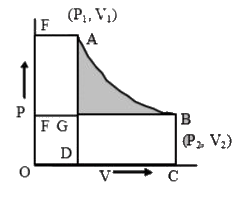Assertion: When ideal gas expand from P1,V1,T1, to P2,V2,T2 two steps, and work done is high in which number of steps are high
Reason: Work is path function
If both assertion and reason are true and reason is the correct explanation of assertion.
If both assertion and reason are true but reason is not the correct explanation of assertion.
If assertion is true but reason is false.
If both assertion and reason are false.
The correct Answer is:B
Step by step video, text & image solution for Assertion: When ideal gas expand from P_(1), V_(1), T_(1), to P_(2), V_(2), T_(2) two steps, and work done is high in which number of steps are high Reason: Work is path function by Chemistry experts to help you in doubts & scoring excellent marks in Class 12 exams.
Topper's Solved these Questions
Similar Questions
Knowledge Check
- Question 1 - Select One or More
An ideal gas is expand from (p1,V1,T1) to (p2,V2,T2) under different conditions. The correct statement(s) among the following is (are):
AThe work done by the gas is less when it is expanded reversibly from V1 to V2 under adiabatic conditions as compared to that when expanded reversibly from V1 to V2 under isothermal conditionsBThe change in internal energy of the gas is (i) zero, if it is expanded reversibly with T1=T2, and (ii) positive, if it is expanded reversibly under adiabatic conditions with T1≠T2CIf the expansion is carried out freely, it is simultaneously both isothermal as well as adiabaticDThe work done on the gas is maximum when it is compressed irreversibly from (P2,V2) to (P1,V1) against constant pressure P1 - Question 2 - Select One
An ideal gas is expand from (p1,V1,T1) to (p2,V2,T2) under different conditions. The correct statement(s) among the following is (are):
AThe work done on the gas is maximum when it is compressed irreversibly from (p2,V2) to (p1,V1) against constant pressure p1.BThe change in internal energy of the gas is (i) zero, if it explained reversibly with T1=T2, and (ii) positive, if it is expanded reversibly under adiabatic conditions with T1≠T2.CIf the expansion is carried out freely, it is simultaneously both isothermal as well as adiabaticDThe work done by the gas is less when it is expanded reversibly from V1 to V2 under adiabatic conditions as compared to that when expanded reversibly from V1 to V2 under isothermal conditions. - Question 3 - Select One or More
An ideal gas is expanded from (p1,V1,T1) to (p2,V2,T2) under different conditions. The correct statement (s) among the following is (are)
AThe work done by the gas is less when it is expanded reversibly from V1 to V2 under adiabatic conditions as compared to that when expanded reversibly from V1 to V2 under isothermal conditionsBThe change in internal energy of the gas is (i) zero, if it is expanded reversibly with T1=T2, positive, if it is expanded reversibly under adiabatic conditions with T1≠T2CIf the expansion is carried out freely, it is simultaneously both isothermal as well as adiabaticDThe work done on the gas is maximum when it is compressed irreversibly from (p2,V2) to (p1,V1), against constant pressure p1
An ideal gas is expand from (p1,V1,T1) to (p2,V2,T2) under different conditions. The correct statement(s) among the following is (are):
View SolutionAn ideal gas follows a process described by PV2=C from (P1,V1,T1) to (P2,V2,T2) (C is a constant). Then
View SolutionIn an adiabatic process, the state of a gas is changed from P1,V1,T1,toP2,V2,T2. Which of the following relation is correct
View SolutionOne mole of hydrogen, assumed to be ideal, is adiabatically expanded from its initial state (P1,V1,T1) to the final state (P2,V2,T2). The decrease in the internal energy of the gas during this process will be given by
View SolutionAn ideal gas is transformed from state A(P1,V1) to the state B(P2,V2) through path AB. In this process the work done by the gas is
 View Solution
View Solution

